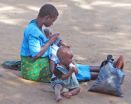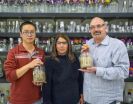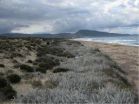(Press-News.org) In this month's edition of Physics World, science writer Richard Corfield casts doubt on the alleged "brainwashing" of the late British astronomer Sir Bernard Lovell by the Soviets at the height of the Cold War and explains how his trips beyond the Iron Curtain laid the foundations for the easing of geopolitical tensions between the UK and the USSR.
Speaking to Lovell's son Bryan, Corfield reveals a more mundane explanation for why Lovell, who founded the Jodrell Bank telescope in the UK, fell ill on his return from the USSR in 1963.
"For me the more likely explanation is that father was simply exhausted – and that gels with the account that he wrote in the contemporaneous diary of the 1963 trip, in which you will find nothing untoward, but plenty of fascinating science," reveals Bryan Lovell, who is the current president of the Geological Society of London.
The alleged brainwashing incident occurred during Lovell's visit to the USSR in 1963 when he was taken on an unexpected tour of the Soviets' new radio-telescope and space-tracking facility in the Crimea, which he was deeply impressed by. On his return to Moscow, Lovell was quizzed on his plans to build a larger telescope at Jodrell Bank, which at the time was the only telescope facility capable of tracking Soviet nuclear-tipped rockets. The Soviets made it clear that if Lovell remained in the USSR and built the facility there, they would give him the money.
Lovell declined the offer and returned to the UK, but immediately fell ill and found that his life had "suddenly turned to dust and ashes", as he wrote in a 2008 memorandum. In the months after his recovery, Lovell was told by the Ministry of Defence that the illness might have been caused by a Soviet attempt to remove his memory of the recruitment offer and what he had seen during his visit.
Despite the incident, Lovell was a fervent believer in the collaborative nature of science – a conviction that was confirmed in the diaries he wrote during the Cold War period, which were released by the University of Manchester after his death in August last year.
Indeed, the British scientific collaboration with the Soviet Union also extended to the field of fusion science, which in 1969 led to a group of leading researchers from the UK Atomic Energy Authority sharing their expertise in measuring plasma temperatures with a Soviet group working on the latest nuclear-fusion technologies.
The fusion collaboration forged in the 1960s ultimately paved the way to the creation of the International Thermonuclear Experimental Reactor (ITER) – a practical attempt to prove that ideas from plasma physics can be translated into full-scale electricity-producing fusion power plants. The first plasma is expected to be produced by ITER in 2020, with the first real working fusion power plants coming – if all goes well – some 20 years after that.
"When – and if – that happens, historians will be able to trace that success back to those early collaborations between Britain and the Soviet Union, and, in part, to the legacy of Sir Bernard Lovell's radio telescope that was used as the earliest of early-warning systems," Corfield writes.
###
Also in this issue:
Beyond the fiscal cliff – what impact will Barack Obama's re-election have on funding for physics?
Nuclear mystery – why physicists are still baffled by a short-lived form of carbon-12 predicted by the astronomer Fred Hoyle that holds the clue to life in the universe
Please mention Physics World as the source of these items and, if publishing online, please include a hyperlink to: http://physicsworld.com
Notes for editors:
1. Physics World is the international monthly magazine published by the Institute of Physics. For further information or details of its editorial programme, please contact the editor, Dr Matin Durrani, tel +44 (0)117 930 1002. The magazine's website physicsworld.com is updated regularly and contains daily physics news and regular audio and video content. Visit http://physicsworld.com.
2. For copies of the articles reviewed here contact Mike Bishop, IOP press officer, tel +44 (0)11 7930 1032, e-mail michael.bishop@iop.org
3. The Institute of Physics is a leading scientific society. We are a charitable organisation with a worldwide membership of more than 45,000, working together to advance physics education, research and application.
We engage with policymakers and the general public to develop awareness and understanding of the value of physics and, through IOP Publishing, we are world leaders in professional scientific communications. Visit us at http://www.iop.org
Doubt cast on Sir Bernard Lovell's brainwashing
2013-01-31
ELSE PRESS RELEASES FROM THIS DATE:
Gut microbes at root of severe malnutrition in kids
2013-01-31
A study of young twins in Malawi, in sub-Saharan Africa, finds that bacteria living in the intestine are an underlying cause of a form of severe acute childhood malnutrition.
The research, led by Washington University School of Medicine in St. Louis and reported Feb. 1 in the journal Science, shows how dysfunctional communities of gut microbes conspire with a poor diet to trigger malnutrition.
The discovery is bolstered by additional studies in mice, showing that gut microbes transplanted from malnourished children cause dramatic weight loss and alter metabolism when ...
Biofuels blend right in
2013-01-31
Winemakers have long known that blending different grape varietals can favorably balance the flavor characteristics of the wine they produce. In the future, makers of advanced biofuels might use a similar strategy, blending different feedstock varieties to balance the energy characteristics of the transportation fuel they produce.
A collaborative study by researchers with the U.S. Department of Energy (DOE)'s Joint BioEnergy Institute (JBEI), a bioenergy research center led by Berkeley Lab, and the Idaho National Laboratory (INL) has shown that an ionic liquid proven ...
In beef production, cow-calf phase contributes most greenhouse gases
2013-01-31
Jan. 30 2013 - Scientists have long known that cattle produce carbon dioxide and methane throughout their lives, but a new study pinpoints the cow-calf stage as a major contributor of greenhouse gases during beef production.
In a new paper for the Journal of Animal Science, scientists estimate greenhouse gas emissions from beef cattle during different stages of life. They show that, depending on which production system farmers used, beef production has a carbon footprint ranging from 10.7 to 22.6 kg of carbon dioxide equivalent per kg of hot carcass weight.
According ...
Confirmed: How plant communities endure stress
2013-01-31
PROVIDENCE, R.I. [Brown University] — Ecology is rife with predation, competition, and other dramatic "negative interactions," but those alone do not determine the course life on Earth. Organisms sometimes benefit each other, too, and according to the Stress Gradient Hypothesis, their "positive interactions" become measurably more influential when ecosystems become threatened by conditions such as drought. Ecologists have argued about the hypothesis ever since Brown University ecologist Mark Bertness co-proposed it in 1994; Bertness says a large new global meta-analysis ...
Peer pressure trumps 'thin' ideals in the media
2013-01-31
Peers exert a greater influence on teenage girls' dissatisfaction with their bodies than do thin ideals in television or social media use, according to new research¹ by Dr. Christopher J. Ferguson and colleagues from Texas A&M International University in the U.S. Their study is published online in Springer's Journal of Youth and Adolescence.
The influence of the media on body image, life satisfaction, and symptoms of eating disorders in teenage girls is a hot debate. Some experts believe that media influences on body dissatisfaction may extend to symptoms of eating disorders. ...
Lake Mead aquatic-science research documents substantial improvements in ecosystem
2013-01-31
LAS VEGAS, Nev. — Lake Mead National Recreation Area's water quality is good, the sport fish populations are sufficient, and the lakes provide important habitat for an increasing number of birds. This positive trend is documented in a new report published today that leads to a better understanding of the natural resources of Lake Mead and Lake Mohave, and the issues that may affect natural resource management of Lake Mead NRA.
"While the Lake Mead ecosystem is generally healthy and robust, the minor problems documented in the report are all being addressed by the appropriate ...
Discovery of sexual mating in Candida albicans could provide insights into infections
2013-01-31
Like many fungi and one-celled organisms, Candida albicans, a normally harmless microbe that can turn deadly, has long been thought to reproduce without sexual mating. But a new study by Professor Judith Berman and colleagues at the University of Minnesota and Tel Aviv University shows that C. albicans is capable of sexual reproduction.
The finding, published online by Nature January 30, represents an important breakthrough in understanding how this pathogen has been shaped by evolution, which could suggest strategies for preventing and treating the often serious infections ...
Are gender and ethnicity risk factors for metabolic syndrome in children?
2013-01-31
New Rochelle, NY, January 30, 2013—Metabolic syndrome is more likely to affect children who are obese than overweight or non-overweight and who have other characteristics associated with the disorder, such as high blood pressure or insulin resistance. A new comprehensive and systematic review of the medical literature on metabolic syndrome in children that probed deeper to evaluate the risk associated with gender, ethnicity, and geography was published in Metabolic Syndrome and Related Disorders, a peer-reviewed journal from Mary Ann Liebert, Inc., publishers. The article ...
Silibinin, found in milk thistle, protects against UV-induced skin cancer
2013-01-31
A pair of University of Colorado Cancer Center studies published this month show that the milk thistle extract, silibinin, kills skin cells mutated by UVA radiation and protects against damage by UVB radiation – thus protecting against UV-induced skin cancer and photo-aging.
"When you have a cell affected by UV radiation, you either want to repair it or kill it so that it cannot go on to cause cancer. We show that silibinin does both," says Rajesh Agarwal, PhD, co-program leader of Cancer Prevention and Control at the CU Cancer Center and professor at the Skaggs School ...
Prostate cancer study tracks long-term urinary, sexual and bowel function side effects
2013-01-31
A new study comparing outcomes among prostate cancer patients treated with surgery versus radiotherapy found differences in urinary, bowel and sexual function after short-term follow-up, but those differences were no longer significant 15 years after initial treatment.
The study, led by first author Matthew Resnick, M.D., instructor in Urologic Surgery, Vanderbilt University Medical Center, was published in the Jan. 31 issue of the New England Journal of Medicine.
From Oct. 1, 1994, through Oct. 31, 1995, investigators enrolled men who had been diagnosed with localized ...




